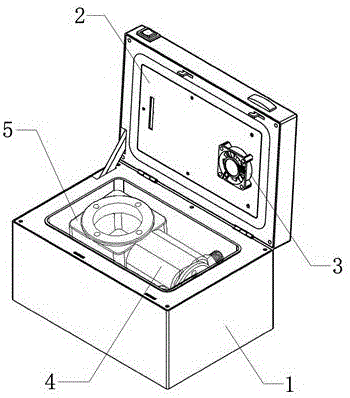Portable tissue sample box
A tissue sample, portable technology, used in shock-sensitive items, containers to prevent decay, locking devices, etc., can solve the problems of inconvenience to carry and use, large size of sterilization instruments, and impact on tissue and organ function, to achieve easy portability. Effect
- Summary
- Abstract
- Description
- Claims
- Application Information
AI Technical Summary
Problems solved by technology
Method used
Image
Examples
Embodiment 1
[0030] Such as figure 1 As shown, a portable tissue sample box includes a box body 1 with a cover, a sample rack 5 is arranged in the box body 1 with a cover, a functional cavity 2 is provided in the cover body of the box body 1 with a cover, and a functional cavity 2 is arranged on the upper surface of the functional cavity 2. The fan 3 and the ultraviolet light source group, the fan 3 is connected with a driving device, and the driving device is arranged inside the functional chamber 2 . The sample holder 5 is connected with the oscillator 4, and the oscillator 4 can generate infrasonic waves, and the frequency range of the infrasonic waves is 17-23 Hz. There is an interlayer in the box body 1 with a lid, and a number of volatilization holes are evenly distributed on the surface of the interlayer. The surface of the volatilization holes is covered with a slow-release film, and the interlayer is filled with volatile sterilizing drugs. The fan 3 keeps rotating at a uniform sp...
Embodiment 3
[0034] 3, the synthetic method of 5-diaminobenzoic acid graft polyethylene glycol monomethyl ester is as follows:
[0035] Put 3,5-diaminobenzoic acid and polyethylene glycol monomethyl ether at a molar ratio of 1.2:1 in a 100mL three-necked round-bottomed flask, add p-toluenesulfonic acid and toluene at a molar ratio of 1:0.2, and 2 The esterification reaction was carried out under protection, and when the temperature of the system reached 65°C, the temperature was kept constant for 60 minutes to make it evenly mixed. Continue to raise the temperature to 120°C for reflux reaction for 2 hours; pour the obtained hot cluster product into cold water, slowly add saturated brine to extract the aqueous solution, and conduct vacuum distillation on the obtained mixture to obtain a viscous product, and then Recrystallization was carried out in a mixed solvent of ethanol: acetonitrile 1:3 to obtain a solid product.
[0036] The synthetic reaction formula is as follows:
[0037]
[...
Embodiment 4
[0042] The synthetic method of 4-(4-aminophenoxy group) phthalic acid is as follows:
[0043] Add p-aminophenol (1.73 g, 15.8 mmol), 4-nitrophthalonitrile (2.29 g, 13.2 mmol), K 2 CO 3 (3.65 g, 26.4 mmol) and DMSO (9 mL), N 2 After stirring for 12 h under the atmosphere, the reaction solution was poured into water to precipitate, filtered and dried. The product 3 was obtained as a gray solid.
[0044] A solution of KOH (7 g, 125 mmol) in water / ethanol (50 mL / 40 mL) was added to a round bottom flask equipped with a magnetic stirring device, N 2 Bubbled for 10 min; Compound 3 (3.3 g, 14 mmol) was added to the reactor, N 2 Stir and reflux under atmosphere for 24h. After the reaction solution is cooled to room temperature, slowly add 10% dilute hydrochloric acid dropwise to the reaction solution; when the pH of the solution is 6-7, a large amount of precipitates precipitate out, filter, wash with tetrahydrofuran, and dry. The product 4 was obtained as a gray solid.
[0045]...
PUM
 Login to View More
Login to View More Abstract
Description
Claims
Application Information
 Login to View More
Login to View More - R&D
- Intellectual Property
- Life Sciences
- Materials
- Tech Scout
- Unparalleled Data Quality
- Higher Quality Content
- 60% Fewer Hallucinations
Browse by: Latest US Patents, China's latest patents, Technical Efficacy Thesaurus, Application Domain, Technology Topic, Popular Technical Reports.
© 2025 PatSnap. All rights reserved.Legal|Privacy policy|Modern Slavery Act Transparency Statement|Sitemap|About US| Contact US: help@patsnap.com



